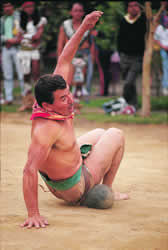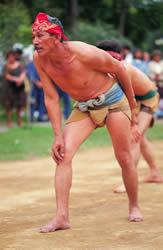|
 |
By:
Rina Cuéllar Zazueta |
|
Scholars have failed to ascertain whether the game was merely a sport, a ritual ceremony or an exercise for warriors. Some historians have linked it to economic or political conflicts, others to the duality of life and death, and day and night, while others have interpreted it as a reflection of cosmic harmony. Very few, however, regard it as the free, creative expression of men who incorporate entertainment into their everyday lives, thereby maintaining the tradition of playing for the sake of playing. This could be said of the survival in Sinaloa of the pre-Hispanic game known as ulama, which experts in the field have identified as a continuation of the ullamaliztli. It has also been defined as one of the oldest, since no archaeological or bibliographical evidence has been found to shed light on the ritual or ceremonial meaning of the game or the existence of solid constructions for playing it, as the codices that comprise Mexico's historiographic heritage have done for Central and Southern Mexico. In Sinaloa, ulama is played purely for entertainment, the origins of its practice having been lost in time. Our research shows that it has been handed down from generation to generation in three main forms. The first and most spectacular is performed with the hips, the only part of the body used to hit a 9-lb solid rubber ball, since a point or mark is lost if it hits another part of the body. The court, 165' long and 13' wide, is divided by a central line separating two teams of five players each. Working out the score is an extremely complicated process, since points are neither added nor subtracted, and the referee omits the number two, counting directly from one to three. This leads to extremely interesting games which can be prolonged for a long time. One game lasted for eight days, although nowadays, in the municipalities of Mazatlán and Escuinapa, where this sport is played, games are stopped two hours after they begin.
Several chroniclers and historians have described or studied the development of ball games played in ancient Mexico from the time of the Conquest until the present. Many have been surprised by the survival of the game known as ulama in Sinaloan land, which researchers such as the historian Ted. J. Leyenaar, who published a fascinating book on the subject, have visited. In Mazatlán, another researcher, Miguel Valadés, has spent over forty years promoting "hip ulama" as well as the manufacture of the ball which is still produced in the traditional fashion. Several factors have ensured the survival of this sport of pre-Hispanic origin in Sinaloa. The perseverance and love of the ulameros who play it and the presence of their fans who really appreciate good shots and above all, the awareness that this is a form of cultural heritage passed down from generation to generation have encouraged the survival of this extraordinary game in Sinaloa, despite the increasing influence of foreign sports and the indifference of the cultural, sports and educational authorities who have never really supported either the development or the knowledge of this pre-Hispanic sport which should be regarded as the state's finest and most authentic cultural heritage in the eyes of the rest of the world. Source: Tips Aeroméxico # 15 Sinaloa / spring 2000 |
|
|

